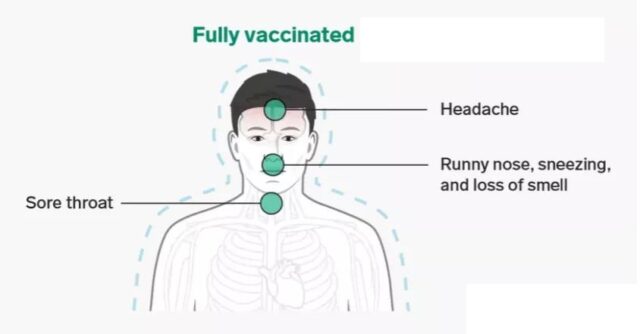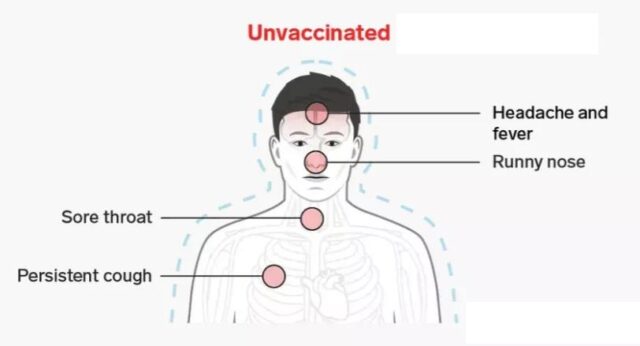Most breakthrough COVID-19 infections are more like allergies
- Normal Liver Cells Found to Promote Cancer Metastasis to the Liver
- Nearly 80% Complete Remission: Breakthrough in ADC Anti-Tumor Treatment
- Vaccination Against Common Diseases May Prevent Dementia!
- New Alzheimer’s Disease (AD) Diagnosis and Staging Criteria
- Breakthrough in Alzheimer’s Disease: New Nasal Spray Halts Cognitive Decline by Targeting Toxic Protein
- Can the Tap Water at the Paris Olympics be Drunk Directly?
Most breakthrough COVID-19 infections are more like allergies
- Should China be held legally responsible for the US’s $18 trillion COVID losses?
- CT Radiation Exposure Linked to Blood Cancer in Children and Adolescents
- FDA has mandated a top-level black box warning for all marketed CAR-T therapies
- Can people with high blood pressure eat peanuts?
- What is the difference between dopamine and dobutamine?
- How long can the patient live after heart stent surgery?
Most breakthrough COVID-19 infections are more like allergies.
Alert! Most breakthrough COVID-19 infections are more like allergies; but still infectious, 0.2%-0.4% died.
With the promotion of vaccination, and high-risk groups began to strengthen vaccination, countries are gradually opening up both internally and externally.
The human rival, the new coronavirus, has also been upgraded to a Delta mutant strain, which ranks among the three most infectious viruses in human history.
The gradually open society and the highly contagious virus mean that many people will be hand-in-hand with the COVID-19 virus. Or according to the CEO of a vaccine company: In the future, almost everyone will be exposed to the Delta mutant strain. The issue of breakthrough infections needs to be seriously considered.
Even more frightening is that the symptoms of patients with breakthrough infection have undergone a radical change, and a large part of patients with breakthrough infection have symptoms that are more like allergies.
picture
A study published in September 2021 by British medical scientists on The Lancet found that fully vaccinated patients had significant sneezing and a significantly lower percentage of fever (73% lower), which was the most prominent of those who had not vaccinated with COVID-19. the difference.
Sneezing, which was originally rare in COVID-19, has become the most common symptom in patients with breakthrough infections.
Characteristics of breakthrough infection cases

The British study summarized the most common symptoms of breakthrough infections in the face of Delta mutant strains, as follows:
Headache
- Runny nose
- sneeze
- sore throat
- Loss of smell
It can be seen that these symptoms are mostly manifestations of upper respiratory tract infections.

If not vaccinated, the most common symptoms of COVID-19 infection, in order are
Headache
- sore throat
- Runny nose
- fever
- Persistent cough
The reason for this significant difference is that the new coronavirus invades the body mainly through the nose.
In people who have not been vaccinated, the body has fewer defense cells to recognize new pathogens, so the virus is difficult to control, and it will soon enter various tissues and organs of the body, especially lung disease becomes the main battlefield, and pneumonia and high fever appear.
People who have been vaccinated have prepared their immune defense systems.
After being vaccinated with a highly effective vaccine, the neutralizing antibody can bind to and eliminate the virus attached to the surface of the nasopharyngeal mucosa, so most people will not be infected or just asymptomatic;
However, as the time of vaccination prolonged, antibody levels decreased, making it difficult to completely prevent the Delta mutant strain from entering the nasopharyngeal cells. But this also activates the memory immune cells induced by the vaccine. T cells are the first to rush in to destroy the virus and release cytokines to recruit reinforcements; B cells are activated in large numbers to reproduce more antibodies.
The nasal cavity has become the main battlefield for fully vaccinated people against the new coronavirus. The fast-reacting immune cells dilate blood vessels and cause sneezing.
In particular, the Delta mutant strain replicates 1,000 times faster than the original strain, and attracts excessive immune cells to gather in the nasal cavity, resulting in obvious symptoms such as runny nose, sneezing, and loss of smell.
What if I feel I am infected with the COVID-19 virus?
First, monitor as soon as possible.
It should be noted that even if the test is negative, but the symptoms are indeed obvious, such as fever, it is still not careless. It is very important to wear a mask throughout the process.
If you are in the United States, people with mild symptoms will be isolated at home; and maintain close communication with your doctor.
However, special attention should be paid to monitoring the pulse oxygen saturation during the process. Once it is lower than 94%, you need to go to the emergency department immediately.
Prognosis of breakthrough infection:
Most of them are mild.
However, a study in Los Angeles in the United States showed that 3.2% of breakthrough infections still required hospitalization and 0.2% died of illness; while a study in India showed that 0.4% of breakthrough infections died. People with underlying diseases and the elderly need special attention.
In addition, it needs to be specially reminded that breakthrough infection cases are still contagious; therefore, it is necessary to also follow the isolation policy to protect family members and other people.
Reference source:
https://www.thelancet.com/journals/laninf/article/PIIS1473-3099(21)00460-6/fulltext
https://covid.joinzoe.com/post/new-top-5-covid-symptoms
Most breakthrough COVID-19 infections are more like allergies
(source:internet, reference only)
Disclaimer of medicaltrend.org
Important Note: The information provided is for informational purposes only and should not be considered as medical advice.



